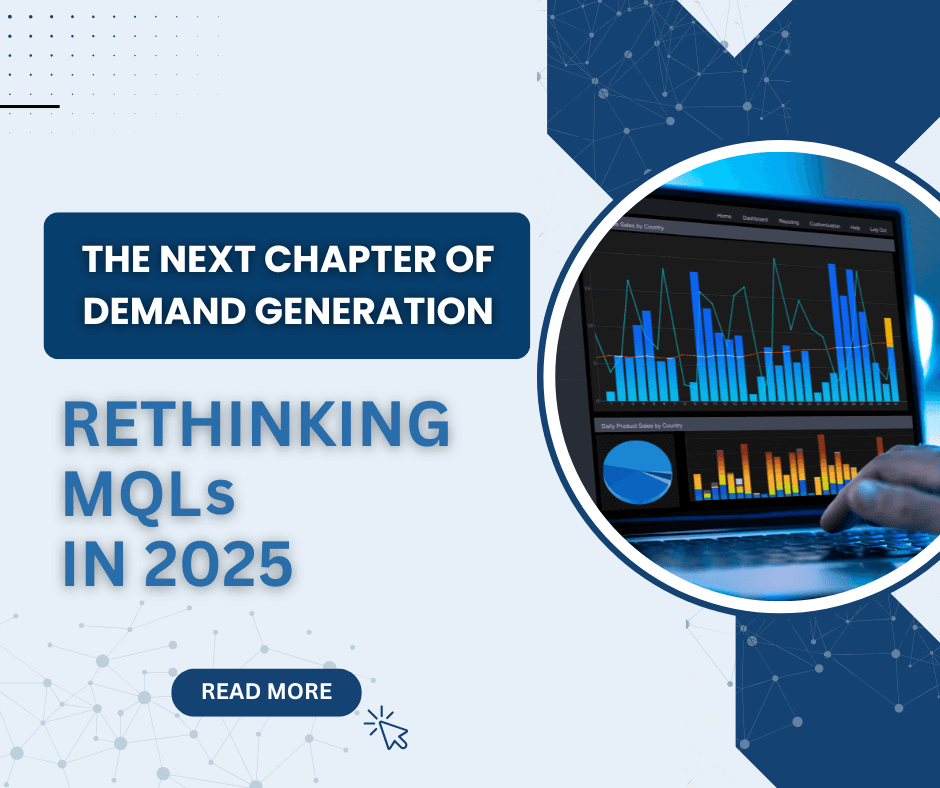1. When Dashboards Deceive: The Illusion of MQL Success
The dashboard glows late into the night. A marketing leader leans in, scanning charts of MQL counts, only to be interrupted by the leadership’s blunt question:
“Where’s the pipeline?”
For years, Marketing Qualified Leads (MQLs) have been the prized metric, the lighthouse guiding demand generation teams. But in today’s volatile, buyer-driven world, that light feels dimmer. Deals stall, buying committees grow larger, and dashboards full of MQLs no longer reassure leadership.
So the question emerges: Are MQLs still pushing us forward, or quietly distracting us from the real work of building revenue pipelines?

2. MQLs in the Rearview: Outdated Signals for Modern Journeys
MQLs rose to prominence in a simpler era of digital marketing. A form fill meant interest. A webinar registration hinted at intent. In that world, tallying MQLs made sense.
But the buying landscape has changed.
According to Gartner, 77% of B2B buyers describe their purchase experience as extremely complex or difficult, shaped by long cycles, multiple decision-makers, and parallel streams of independent research.
That complexity makes the MQL a blunt instrument. A single form fill no longer reflects true momentum. It measures clicks, not commitment. In fact, many teams now admit their most “qualified” leads rarely map to sales’ reality.
The problem isn’t that MQLs are useless, it’s that they’re incomplete. They’re a legacy signal in a modern maze, and when treated as the primary north star, they leave marketing teams celebrating numbers while revenue leaders wait for impact.
3. Decoding Buyer Intent: The New Currency of Context
This is where intent data changes the conversation. Unlike MQLs, intent looks deeper, into patterns of behaviour across multiple layers of the buyer’s journey.
HubSpot reports that businesses using its Marketing Hub achieve 505% average ROI over three years, powered not by form fills, but by intelligent, behaviour-driven engagement.
The new playbook rests on three tiers of intent intelligence:
- First-party: your owned signals, such as website visits, content downloads, repeat engagements, and time spent on high-value pages. These reveal how deeply prospects are interacting with your brand and where they are in their journey.
- Second-party: trusted partner data, event co-registrations, cross-platform overlaps. These expand your visibility into overlapping audiences and validate interest beyond your own ecosystem.
- Third-party: aggregated industry signals that reveal hidden research activity. These signals uncover anonymous but active accounts showing category-level interest, often before they ever appear on your radar.
When connected, these signals give a holistic, living view of buyer context. Where MQLs say, “someone clicked,” intent data says, “this account is moving deeper into evaluation.” It’s the difference between chasing shadows and decoding the buyer’s actual language.

4. The Alignment Gap: How MQLs Divide Sales and Marketing
The cracks appear most visibly between marketing and sales. Marketing waves its MQL dashboards, proud of the volume. Sales, on the other hand, demands ready-to-buy conversations.
Forrester research reveals the disconnect: while 82% of C-level B2B leaders believe their sales and marketing are aligned, 65% of practitioners say otherwise. MQLs often sit at the heart of that misalignment.
Why? Because they’re frequently handed off without context, forcing sales to chase leads that lack buying intent. What begins as a “lead” becomes friction, frustration, and fragmented stories.
Instead of being a bridge, the MQL often becomes a barrier. Without a shared framework, marketing optimises for volume while sales optimises for value, and both miss the bigger picture of revenue growth.
5. From Lead Counts to Revenue Continuums: Redefining the Funnel
The answer isn’t to abandon MQLs, but to reframe them. On their own, they’re shallow. Within a revenue-centric continuum, they become early signals in a bigger story.
Here’s the modern continuum:
- Engagement/MQL: top-funnel interactions, awareness markers.
- Intent signals: research behaviours and account-level momentum.
- Sales Qualified Leads (SQL): readiness validated by sales.
- Pipeline validation: authority, budget, need, and timing confirmed.
Forrester urges marketers to shift from one-off lead scoring to buyer group frameworks, reflecting how real committees make real decisions. The continuum respects MQLs as part of the picture, but no longer the whole canvas.
The key is shared KPIs. Not “leads passed,” but opportunities created, pipeline generated, and deals progressed. It’s about moving from counting people who clicked to tracking buying groups progressing.
6. The Playbook for Turning MQLs into Measurable Value
How do businesses transform MQLs from vanity to value? Three plays stand out:
- Fuse MQLs with intent scoring: Don’t discard form fills; enrich them with first-, second, and third-party behaviours to see the whole picture.
- Adopt buying-group frameworks: Stop thinking in single leads.
Forrester shows that aligning around buying groups sharpens revenue outcomes.
- Unify KPIs across marketing and sales: Shift from leads-passed to pipeline influenced. The goal is shared growth, not departmental scoreboard wins.
The results are tangible.
HubSpot’s ROI numbers demonstrate how smart integrations of MQLs, intent, and automation drive outsized returns when alignment is achieved.
When viewed this way, MQLs regain relevance, not as vanity trophies, but as one thread in a revenue-woven fabric.

7. Acumen Intelligence: Where Strategy Meets Scalable Execution
Acumen Intelligence steps in, not by clinging to old definitions of MQLs, but by helping businesses operationalise the evolution.
- Demand Generation & Database Marketing: Prioritise accounts and decision-makers who actually have purchase intent, not just clicks.
- Data-Driven Strategies & Automation: Streamline qualification so every “lead” is context-rich and sales-ready.
- Global Reach: With access to 25M+ decision-makers worldwide, Acumen accelerates account engagement at scale.
- ROI Focus: Minimise cost per lead, maximise quality, and ensure measurable revenue impact.
In short, Acumen helps businesses stop chasing lead volume and start building pipelines that convert. MQLs evolve from mere metrics into milestones on a smarter journey, bridging the gap between data and deals.
8. Beyond the Lead: Chasing Growth in 2025
MQLs aren’t dead. They’re evolving. Once the star player, they now find their strength as part of a broader growth mosaic, interwoven with intent signals, account insights, and revenue alignment.
The leadership mindset shift is clear: it’s no longer about counting leads. It’s about orchestrating journeys and outcomes.
In 2025, the businesses that thrive won’t be the ones with the biggest lead lists. They’ll be the ones that see MQLs not as an end point, but as an entry point, one that connects to intent, alignment, and pipeline.
The future belongs to those who evolve.

